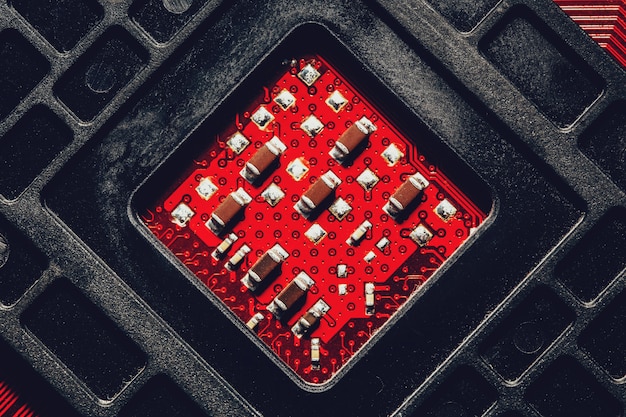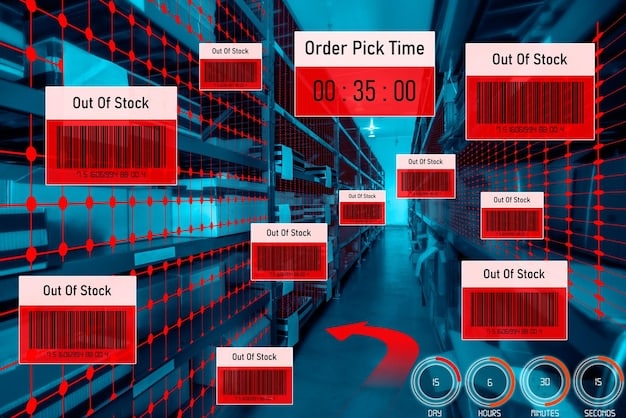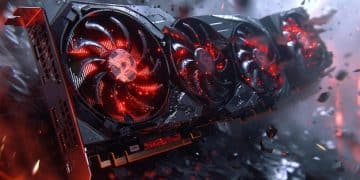AMD CrossFireX in 2025: Is Multi-GPU Technology Still Worth It?

AMD’s CrossFireX, once a promising multi-GPU technology, faces an uncertain future in 2025 due to evolving gaming technologies, diminishing developer support, and the rise of more efficient single-GPU solutions, leading to questions about its relevance in modern gaming setups.
Is AMD’s Multi-GPU Technology: Is CrossFireX Still Relevant in 2025? The answer isn’t straightforward. Once a popular choice for gamers seeking a performance boost, CrossFireX now faces stiff competition and dwindling support. Let’s explore whether it still holds value in the evolving landscape of PC gaming.
Understanding AMD CrossFireX Technology
AMD CrossFireX technology, at its core, is a multi-GPU solution designed to enhance graphics performance by linking two or more compatible AMD graphics cards. This technology allows these cards to work in tandem, theoretically doubling or tripling the rendering power available for games and other graphically intensive applications. However, the reality is often more complex than the theory.
How CrossFireX Works
CrossFireX functions by splitting the rendering workload between the connected GPUs. Several rendering modes exist, including Alternate Frame Rendering (AFR), where each GPU renders alternate frames, and Split Frame Rendering (SFR), where each GPU renders a portion of each frame. The goal is to distribute the work evenly to maximize performance.
- Alternate Frame Rendering (AFR): Divides work by assigning each GPU to render alternate frames.
- Split Frame Rendering (SFR): Splits each frame into sections, having GPUs render different parts.
- CrossFireX Bridge: Connects the cards, ensuring synchronized operations.
However, the efficiency of CrossFireX heavily relies on game developers optimizing their titles to properly utilize multiple GPUs.
Compatibility and Setup
Setting up CrossFireX requires a compatible motherboard, two or more compatible AMD graphics cards, and a CrossFire bridge to physically connect the cards. The motherboard must support multiple GPUs, and the graphics cards need to be from the same series for optimal compatibility. Once the hardware is set up, users typically need to enable CrossFireX in the AMD Radeon settings software.
Proper driver support is also crucial; outdated or poorly optimized drivers can lead to performance issues and instability.

The Rise and Fall of Multi-GPU Solutions
Multi-GPU solutions, including CrossFireX and NVIDIA’s SLI, were once seen as the future of PC gaming, promising significant performance gains over single-GPU setups. However, their popularity has waned over the years due to various factors, including limited game support, compatibility issues, and the rise of more powerful single GPUs.
Initial Enthusiasm
In the early days, multi-GPU configurations offered a viable path to achieving higher frame rates and better visual fidelity, especially in demanding games. Enthusiasts eagerly adopted these technologies to push the boundaries of gaming performance. The promise of doubling the graphics processing power was very appealing.
Early adopters experienced impressive gains in some titles, solidifying the appeal of CrossFireX and SLI.
Challenges and Roadblocks
Despite the initial enthusiasm, multi-GPU solutions faced several challenges that ultimately hindered their widespread adoption. One of the most significant issues was the lack of consistent game support. Developers often prioritized optimizing their games for single GPUs, leaving multi-GPU configurations underutilized or prone to issues.
- Inconsistent Game Support: Games not optimized for multi-GPU setups.
- Micro-stuttering: Uneven frame delivery causing a choppy experience.
- Driver Issues: Compatibility and optimization problems.
Another challenge was micro-stuttering, a phenomenon where uneven frame delivery caused a perceived choppy or laggy experience, even at high average frame rates. These issues, combined with driver problems and compatibility headaches, made multi-GPU setups less attractive to the average gamer.
Current State of CrossFireX in 2024
As we approach 2025, the relevance of CrossFireX continues to diminish. AMD has shifted its focus towards single-GPU solutions, and support for CrossFireX in new games is becoming increasingly rare. While some older titles may still benefit from the technology, its overall value proposition is questionable in the modern gaming landscape.
Official Support and Driver Updates
AMD’s official support for CrossFireX has waned, with fewer driver updates specifically targeting multi-GPU configurations. This lack of support means that newer games are unlikely to receive the necessary optimizations to run smoothly on CrossFireX setups. The focus is clearly on optimizing performance for their latest single-GPU offerings.
Users may find themselves relying on older drivers or community-created fixes to get CrossFireX working on some games, adding to the complexity and potential instability of the setup.

Alternatives and Emerging Technologies
With the decline of CrossFireX, gamers seeking improved performance have turned to alternative solutions, such as upgrading to a more powerful single GPU or exploring emerging technologies like cloud gaming. Single GPUs have become increasingly capable, often delivering better performance and a smoother experience than multi-GPU setups.
Cloud gaming services offer another alternative, allowing users to stream games from powerful remote servers, eliminating the need for expensive hardware upgrades.
Future Prospects for AMD Multi-GPU Technology in 2025
Looking ahead to 2025, the future of AMD’s multi-GPU technology appears bleak. With diminishing support, limited game optimization, and the rise of powerful single-GPU solutions, it’s unlikely that CrossFireX will remain relevant. However, there may still be niche applications or specific scenarios where multi-GPU setups could offer some value.
Potential Niche Applications
While CrossFireX may not be ideal for mainstream gaming, it could still find use in specific niche applications, such as professional workstations running tasks that can effectively utilize multiple GPUs. Applications like video editing, 3D rendering, and scientific simulations may benefit from the additional processing power.
However, even in these scenarios, the limitations and complexities of multi-GPU setups may outweigh the benefits compared to more streamlined solutions.
Impact of New Technologies
The emergence of new technologies, such as advanced upscaling techniques and more efficient rendering methods, could further reduce the need for multi-GPU configurations. These technologies aim to improve performance and visual fidelity without requiring additional hardware, making single GPUs even more appealing.
- Upscaling Technologies: Improving visual quality without requiring high resolutions.
- Efficient Rendering Methods: Optimizing how scenes are rendered to reduce GPU load.
- DirectStorage: Enhancing game loading times and reducing CPU overhead.
DirectStorage, for example, promises to enhance game loading times and reduce CPU overhead, further improving the overall gaming experience on single-GPU systems.
Is CrossFireX Worth Considering in 2025?
In conclusion, whether CrossFireX is worth considering in 2025 depends heavily on individual circumstances and specific use cases. For most gamers, the answer is likely no. The lack of consistent game support, potential compatibility issues, and the availability of more efficient alternatives make CrossFireX a less attractive option than upgrading to a single, more powerful GPU.
Factors to Consider
Despite its limitations, there may be a few scenarios where CrossFireX could still be worth considering. These include:
- Having existing compatible hardware and wanting to squeeze out extra performance in older titles.
- Using CrossFireX for non-gaming applications that can effectively utilize multiple GPUs.
- Being willing to troubleshoot and experiment to get CrossFireX working on specific games.
However, it’s essential to weigh these potential benefits against the challenges and complexities associated with multi-GPU setups.
Making an Informed Decision
Ultimately, the decision to use CrossFireX in 2025 should be based on careful consideration of your individual needs and circumstances. If you’re a gamer looking for the best possible performance and a hassle-free experience, a single, high-end GPU is likely the better choice. If you have specific niche applications or are willing to tinker with your system to get the most out of your hardware, CrossFireX may still offer some value.
It’s crucial to stay informed about the latest hardware and software developments and to read reviews and benchmarks to make an informed decision.
| Key Point | Brief Description |
|---|---|
| 🎮 Diminishing Game Support | Fewer new games optimize for CrossFireX, limiting its usefulness. |
| 📈 Single GPU Advances | Single GPUs offer strong performance, often exceeding CrossFireX setups. |
| 🛠️ Compatibility Issues | CrossFireX can suffer from driver and game compatibility problems. |
| ☁️ Cloud Gaming | Cloud gaming presents an alternative to high-end hardware setups. |
Frequently Asked Questions
▼
AMD CrossFireX is a multi-GPU technology that allows multiple AMD graphics cards to work together to enhance graphics performance. It aims to provide higher frame rates and better visual fidelity in games and other graphically intensive applications.
▼
CrossFireX is losing relevance due to diminishing game support, the rise of more powerful single GPUs, and compatibility issues. Game developers are increasingly focusing on optimizing for single GPUs, leaving multi-GPU setups underutilized.
▼
Alternatives to CrossFireX include upgrading to a higher-end single GPU, utilizing cloud gaming services, or exploring newer upscaling technologies. These options often provide better performance and a smoother experience without the complexity of multi-GPU setups.
▼
CrossFireX may still be useful in 2025 for specific niche applications, such as professional workstations or older games that benefit from multi-GPU setups. However, the limited support and potential issues make it less desirable for most gamers.
▼
Before using CrossFireX, consider the lack of consistent game support, potential compatibility issues, and the availability of more efficient alternatives. Evaluate your specific needs and whether the benefits outweigh the challenges associated with multi-GPU setups.
Conclusion
In summary, while AMD’s Multi-GPU Technology: Is CrossFireX Still Relevant in 2025?, the evidence suggests that its role will be minimal. The gaming industry’s shift towards single-GPU optimization and the rise of cloud gaming present more viable options, signaling a decline for CrossFireX unless significant advancements or niche applications emerge.





